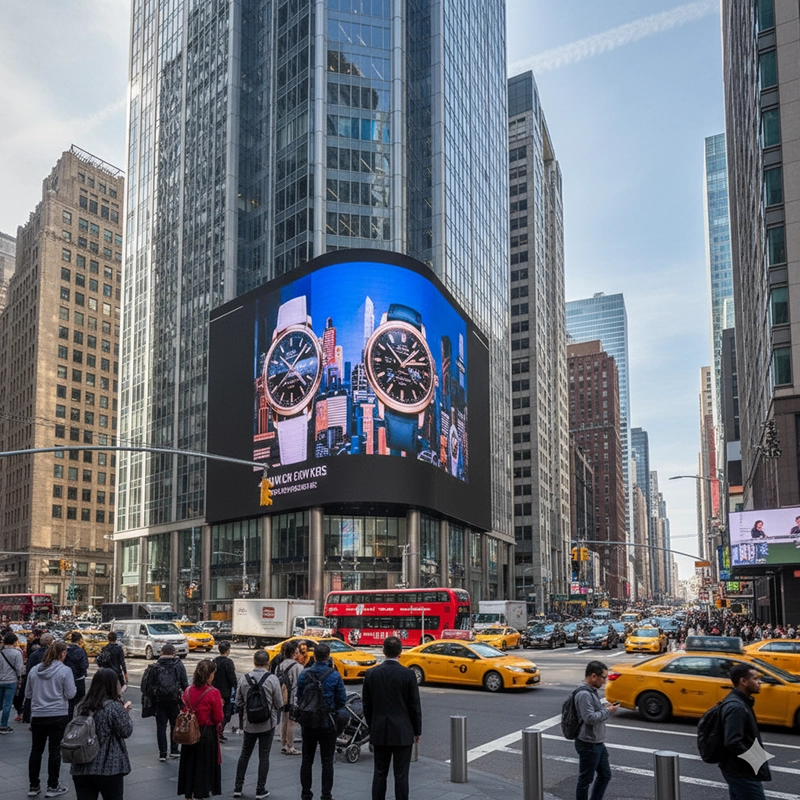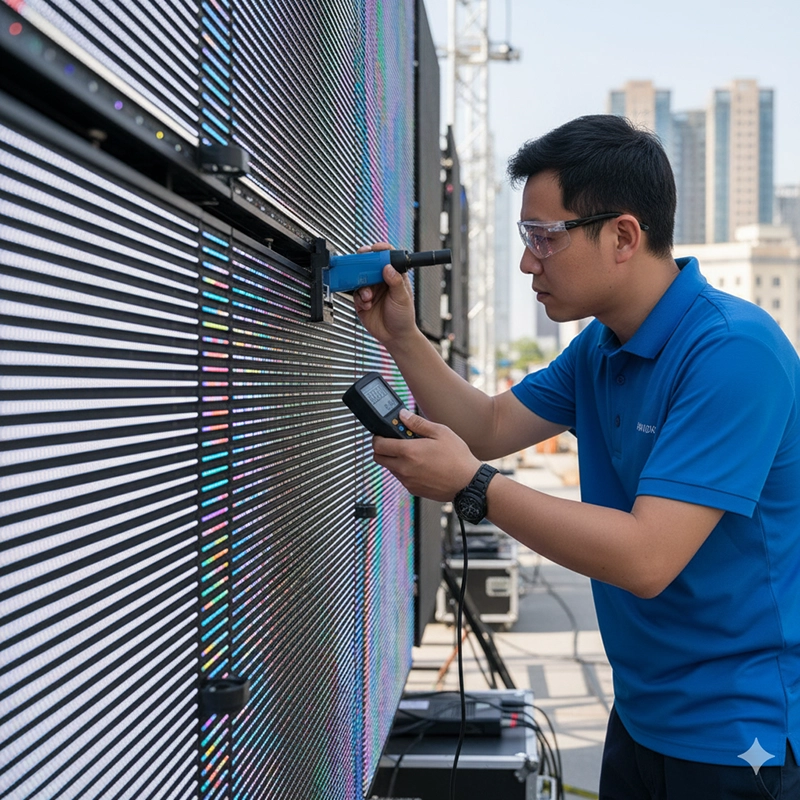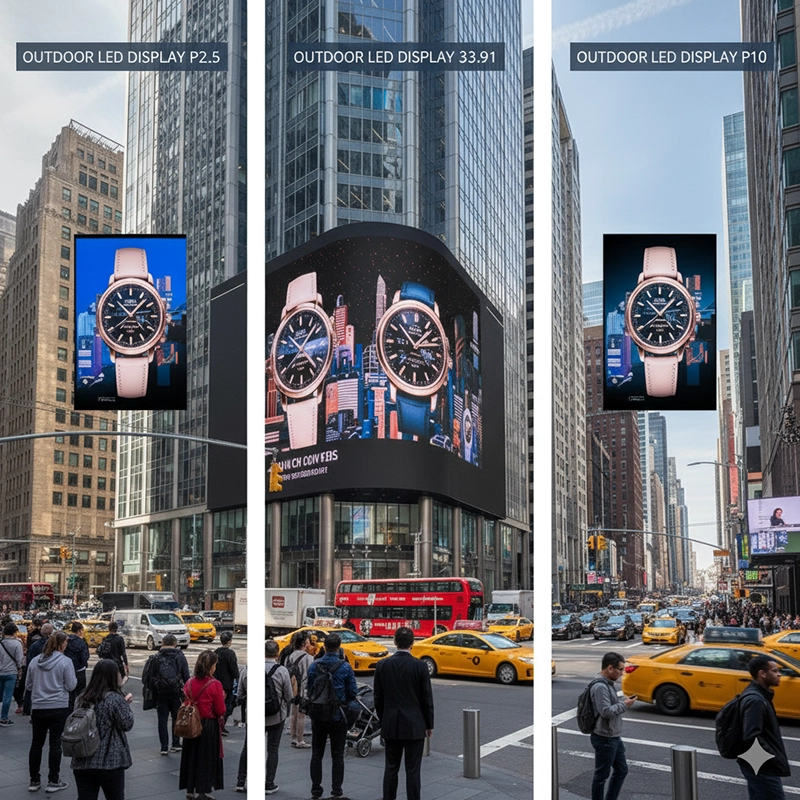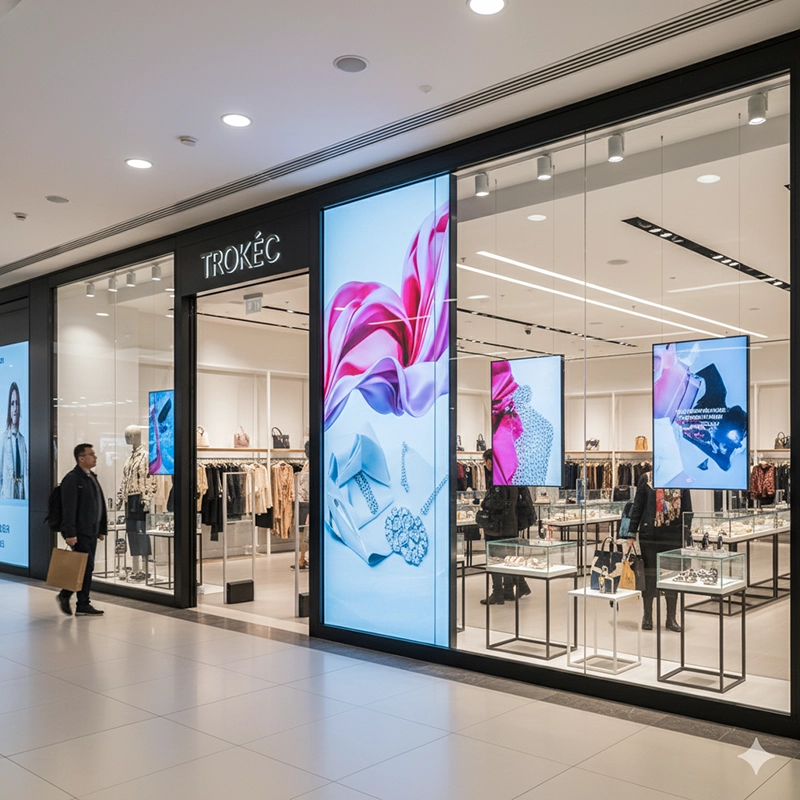Outdoor LED displays are large-format digital screens specifically designed for outdoor use. Built with high-brightness diodes and durable structures, they are engineered to withstand sunlight, rain, dust, and temperature variations while delivering vivid images and videos to wide audiences. These displays are commonly used in advertising billboards, stadiums, concerts, public squares, and transportation hubs. Their ability to provide real-time updates, high visibility, and creative formats makes them one of the most powerful communication tools in modern cities.
צג LED חיצוני הוא סוג מיוחד של מסך דיגיטלי שנועד לפעול ביעילות בסביבות פתוחות. בניגוד לצגי LED פנימיים שמעדיפים בהירות מטווח קרוב ובהירות עדינה, מסכי LED חיצוניים מיוצרים עם בהירות גבוהה יותר, עמידות בפני מזג אוויר וראות בקנה מידה גדול כתכונות העיקריות שלהם.
צגי LED חיצוניים מורכבים מפאנלים מודולריים של LED שניתן להרכיב בצורות וגדלים שונים. כל מודול מכיל אלפי דיודות פולטות אור המסודרות בפיקסלים היוצרות תמונות וסרטונים. רמות הבהירות של דיודות אלו הן לרוב בין 5,000 ל-10,000 ניטים, מה שמאפשר לתצוגה להישאר גלויה גם באור שמש ישיר. דגמים מתקדמים משלבים מערכות התאמת בהירות אוטומטיות המווסתות את הפלט בהתבסס על תנאי תאורת הסביבה, ומבטיחות ראות אופטימלית מבלי לבזבז אנרגיה.
עמידות היא דרישה בסיסית עבור צגי LED חיצוניים. יצרנים מתכננים מערכות אלו עם דירוגי עמידות למים IP65 ומעלה, כלומר התצוגה אטומה מפני גשם, אבק ומזהמים חיצוניים אחרים. הארונות המכילים את המודולים בנויים מחומרים עמידים בפני קורוזיה, לרוב אלומיניום או פלדה, והם כוללים אוורור יעיל או מערכות פיזור חום ללא מאוורר כדי למנוע התחממות יתר במהלך פעולה ממושכת.
גורם מבחין נוסף הוא גובה הפיקסלים, המתייחס למרחק בין שני פיקסלים סמוכים. למסכי LED חיצוניים יש בדרך כלל גובה פיקסלים גדול יותר בהשוואה לדגמים פנימיים, החל מ-P2.5 עד P10 או יותר, בהתאם למרחק הצפייה. לדוגמה, תצוגת LED חיצונית P10 אידיאלית לשלטי חוצות בכבישים מהירים הנצפים ממרחק של 50-100 מטרים, בעוד שמסך P3.91 עשוי לשמש ללוחות תוצאות באצטדיונים שבהם הקהל קרוב יותר.
פונקציונליות משתרעת מעבר לפרסום פשוט. צגי LED חיצוניים יכולים לתמוך בסטרימינג וידאו חי, תוכן אינטראקטיבי ומערכות בקרה מבוססות רשת. עסקים ורשויות מקומיות מחברים אותם לעתים קרובות לפלטפורמות תוכנה מרכזיות, מה שמאפשר למפעילים לעדכן תוכן מרחוק ובזמן אמת. גמישות זו הופכת אותם מתאימים ליישומים מגוונים כגון עדכוני תנועה, התראות חירום, שידורי ספורט חיים ואירועי תרבות.
בהשוואה לשלטי חוצות סטטיים מסורתיים, מסכי LED חיצוניים מספקים דינמיות שאין שני לה. במקום להדפיס פוסטרים חדשים, מפעילים יכולים לשנות תוכן באופן מיידי, לתזמן קמפיינים שונים לאורך היום, ואף לשלב אנימציות או סרטונים כדי למשוך תשומת לב. יכולת הסתגלות זו לא רק מגבירה את המעורבות אלא גם מפחיתה עלויות ארוכות טווח הקשורות להדפסה ולוגיסטיקה.
השילוב של נראות גבוהה, מבנה עמיד בפני מזג אוויר, גמישות מודולרית וניהול תוכן דינמי מגדיר מהי באמת תצוגת LED חיצונית. זהו שילוב של אלקטרוניקה מתקדמת, הנדסה חזקה וטכנולוגיית תקשורת יצירתית, המעצב את האופן שבו עסקים, ארגונים וממשלות מקיימים אינטראקציה עם הציבור בסביבות חיצוניות.
אימוץ מסכי LED חיצוניים זינק ברחבי העולם בשל יתרונותיהם הרבים.
נראות מעולה: עם רמות בהירות העולות בהרבה על מסכי LCD מסורתיים, צגי LED חיצוניים מבטיחים שהתוכן יישאר חי גם באור שמש ישיר.
עמידות ואורך חיים: מסכים אלה, המיועדים לתנאי חוץ קשים, יכולים להחזיק מעמד למעלה מ-100,000 שעות עם תחזוקה נאותה. טכנולוגיית ה-LED שלהם חסכונית יותר באנרגיה בהשוואה למערכות תאורה ישנות יותר.
התקנה גמישה: ניתן להתקין צגי LED חיצוניים על חזיתות בניינים, מבנים עצמאיים, גגות או מערכי השכרה זמניים לקונצרטים ופסטיבלים.
תוכן דינמי: מפעילים יכולים לעבור בקלות בין פרסומות, סרטונים ושידורים חיים, וליצור חוויות מרתקות ביותר עבור הקהל.
פרסום חסכוני: עם הזמן, שלטי חוצות LED חיצוניים מפחיתים עלויות חוזרות הקשורות להדפסה והתקנה של שילוט סטטי.
צגי LED חיצוניים מגיעים במספר צורות, כל אחת מתאימה ליישומים שונים:
צגי LED חיצוניים קבועים: התקנות קבועות לפרסום, הכרזות לציבור או ציוני דרך בעיר.
השכרת מסכי לד חיצוניים: מסכים ניידים לקונצרטים, פסטיבלים ואירועים עסקיים. אלה קלים משקל ומתוכננים להתקנה ופירוק מהירים.
מסכי LED שקופים לחוץ: מיושמים בחנויות או באדריכלות יצירתית, מאפשרים אור וראות מאחורי המסך ועדיין מציגים ויזואליה חיה.
צגי LED גמישים: מסכים מעוקלים או בעלי צורה ייחודית המיועדים לשילוב אדריכלי ואפקטים חזותיים יצירתיים.
צגי LED היקפיים: נפוצים באצטדיונים, צגים ארוכים ורציפים אלה עוטפים מגרשי משחקים ומספקים תוצאות בזמן אמת ופרסומות של נותני חסות.
כל סוג מותאם למקרי שימוש ספציפיים, מה שמבטיח שעסקים ומארגני אירועים יוכלו למצוא פתרון המתאים ליעדי התקשורת שלהם.
יישומים של צגי LED חיצוניים הם נרחבים וממשיכים להתרחב עם שיפורים טכנולוגיים. הם כוללים:
פרסום ושלטי חוצות דיגיטליים: כבישים מהירים, מרכזי קניות ומרכזי ערים נהנים ממסכי LED חיצוניים גדולים לקידום מותג.
זירות ספורט ואצטדיונים: לוחות תוצאות, מסכים היקפיים וקירות וידאו ענקיים משפרים את חוויות הצפייה החיות עבור הצופים.
מרכזי תחבורה ציבורית: שדות תעופה, תחנות רכבת וטרמינלים של אוטובוסים משתמשים בצגי LED חיצוניים כדי להציג לוחות זמנים, התראות בטיחות ופרסומות.
קונצרטים ופסטיבלים: מסכי LED חיצוניים להשכרה משמשים כרקע, ויזואליה על הבמה וכלי ליצירת מעורבות קהל.
מקומות דתיים: כנסיות מאמצות יותר ויותר מסכי LED כדי להציג מזמורים, מסרים ושידורים חיים לקהילות.
יישומים מגוונים אלה מדגישים את הרבגוניות של צגי LED חיצוניים בחברה המודרנית.
עלות היא אחד השיקולים הקריטיים ביותר בעת הערכת צגי LED חיצוניים, והיא מושפעת מגורמים רבים הקשורים זה בזה. הבנת משתנים אלה עוזרת לקונים ולמנהלי רכש לקבל החלטות מושכלות וליישר קו בין השקעותיהם ליעדים ארוכי טווח.
גובה הפיקסל משפיע באופן משמעותי על המחיר. גובהי פיקסלים קטנים יותר, כגון P2.5 או P3.91, מספקים תמונות חדות יותר המתאימות למרחקי צפייה קרובים יותר, אך דורשים יותר נוריות LED למטר מרובע, מה שמגדיל את עלויות הייצור וההתקנה. גובהי פיקסלים גדולים יותר כמו P8 או P10 הם זולים יותר למטר מרובע, אך מיועדים לקהל רחוק יותר. לכן, קביעת גובה הפיקסל האופטימלי על סמך מרחק הצפייה משפיעה ישירות על תכנון התקציב.
המידות הכלליות של התצוגה, כמו גם סוג המבנה התומך, משפיעות מאוד על העלות. שלט חוצות גדול בכביש מהיר דורש מסגרות פלדה חזקות ויסודות מחוזקים, בעוד שתצוגה קטנה של חנות יכולה להיות מותקנת על מבנה קל משקל. בנוסף, צורות לא סדירות או מותאמות אישית, כגון תצוגות מעוקלות או גליליות, דורשות הנדסה מיוחדת המגדילה הן את הוצאות התכנון והן את הוצאות הייצור.
צגי LED חיצוניים בעלי בהירות גבוהה צורכים יותר חשמל. עם זאת, דיודות חסכוניות באנרגיה ומערכות בקרת בהירות חכמות מסייעות להפחית את חשבונות החשמל לאורך זמן. צגים מתקדמים משלבים חיישנים שמתאימים אוטומטית את הבהירות בהתאם לאור הסביבה, מה שמפחית את עלויות התפעול תוך הארכת חיי הדיודה. ההשקעה הראשונית עשויה להיות גבוהה יותר עבור דגמים אלה, אך עלות הבעלות הכוללת לרוב נמוכה יותר.
מסכי LED חיצוניים חייבים לעמוד בפני גשם, שלג, רוח ואבק. דירוגי IP גבוהים יותר (למשל, IP65 או IP68) כרוכים בטכנולוגיות איטום מתקדמות וחומרים חזקים, אשר מגדילים את העלויות הראשוניות. באופן דומה, טיפולים נגד קורוזיה וארונות אלומיניום איכותיים יקרים יותר אך חיוניים לאמינות ארוכת טווח בסביבות חוף או לחות. על הקונים לאזן בין הוצאות ראשוניות לבין החיסכון הצפוי בתחזוקה והחלפה.
מסכי LED בסיסיים לשימוש חיצוני עשויים לכלול עדכוני תוכן פשוטים מבוססי USB, אך תצוגות מתקדמות מסתמכות על מערכות בקרה מבוססות ענן או רשת המאפשרות תזמון וניטור תוכן בזמן אמת. חבילות תוכנה וחומרה אלו מגיעות עם דמי רישוי, חוזי שירות מתמשכים ועלויות התקנה ראשוניות גבוהות יותר, אך הן מאפשרות גמישות וגמישות רבה יותר.
השכרת צגי LED חיצוניים מתומחרים בצורה שונה מהתקנות קבועות. בעוד ששכירות עשויה להפחית עלויות ראשוניות, שימוש תכוף יכול להפוך את הבעלות לחסכונית יותר לאורך זמן. מארגני אירועים חייבים לשקול את נוחות ההשכרה לטווח קצר מול הערך לטווח ארוך של בעלות על תצוגה מותאמת אישית.
המחירים משתנים מאוד בין יצרנים וספקים. גורמים כמו ארץ המוצא, מוניטין המותג, שירות לאחר המכירה וכיסוי האחריות תורמים לעלות הכוללת. ספק המציע אחריות מורחבת, תחזוקה באתר וזמינות חלקי חילוף עשוי לגבות יותר בהתחלה אך לספק תמורה טובה יותר לטווח ארוך. קונים בינלאומיים צריכים לשקול גם משלוח, מכסי יבוא ותמיכה בהתקנה.
תכונות מיוחדות כגון עיצובים מעוקלים, מודולים שקופים, יכולת מגע אינטראקטיבית או שילוב עם יישומי מציאות רבודה/מציאות מגבירות את המורכבות והעלות. אפשרויות אלו יכולות לשפר את מעורבות הקהל אך יש להעריך אותן על סמך החזר ההשקעה והשימוש המיועד.
כאשר כל הגורמים הללו נלקחים בחשבון יחד, העלות הכוללת של צג LED חיצוני הופכת לאיזון בין ביצועים, עמידות ויעילות תפעולית לטווח ארוך. קונים צריכים לא רק להשוות מחירי יחידה למטר מרובע, אלא גם לחשב את עלויות לכל החיים, כולל התקנה, צריכת אנרגיה, תחזוקה ושדרוגים. גישה מקיפה זו מבטיחה שההשקעות תואמות הן את המגבלות הפיננסיות והן את יעדי התקשורת.
Outdoor LED displays are large-format digital screens specifically designed for outdoor use. Built with high-brightness diodes and durable structures, they are engineered to withstand sunlight, rain, dust, and temperature variations while delivering vivid images and videos to wide audiences. These displays are commonly used in advertising billboards, stadiums, concerts, public squares, and transportation hubs. Their ability to provide real-time updates, high visibility, and creative formats makes them one of the most powerful communication tools in modern cities.
צג LED חיצוני הוא סוג מיוחד של מסך דיגיטלי שנועד לפעול ביעילות בסביבות פתוחות. בניגוד לצגי LED פנימיים שמעדיפים בהירות מטווח קרוב ובהירות עדינה, מסכי LED חיצוניים מיוצרים עם בהירות גבוהה יותר, עמידות בפני מזג אוויר וראות בקנה מידה גדול כתכונות העיקריות שלהם.
צגי LED חיצוניים מורכבים מפאנלים מודולריים של LED שניתן להרכיב בצורות וגדלים שונים. כל מודול מכיל אלפי דיודות פולטות אור המסודרות בפיקסלים היוצרות תמונות וסרטונים. רמות הבהירות של דיודות אלו הן לרוב בין 5,000 ל-10,000 ניטים, מה שמאפשר לתצוגה להישאר גלויה גם באור שמש ישיר. דגמים מתקדמים משלבים מערכות התאמת בהירות אוטומטיות המווסתות את הפלט בהתבסס על תנאי תאורת הסביבה, ומבטיחות ראות אופטימלית מבלי לבזבז אנרגיה.
עמידות היא דרישה בסיסית עבור צגי LED חיצוניים. יצרנים מתכננים מערכות אלו עם דירוגי עמידות למים IP65 ומעלה, כלומר התצוגה אטומה מפני גשם, אבק ומזהמים חיצוניים אחרים. הארונות המכילים את המודולים בנויים מחומרים עמידים בפני קורוזיה, לרוב אלומיניום או פלדה, והם כוללים אוורור יעיל או מערכות פיזור חום ללא מאוורר כדי למנוע התחממות יתר במהלך פעולה ממושכת.
גורם מבחין נוסף הוא גובה הפיקסלים, המתייחס למרחק בין שני פיקסלים סמוכים. למסכי LED חיצוניים יש בדרך כלל גובה פיקסלים גדול יותר בהשוואה לדגמים פנימיים, החל מ-P2.5 עד P10 או יותר, בהתאם למרחק הצפייה. לדוגמה, תצוגת LED חיצונית P10 אידיאלית לשלטי חוצות בכבישים מהירים הנצפים ממרחק של 50-100 מטרים, בעוד שמסך P3.91 עשוי לשמש ללוחות תוצאות באצטדיונים שבהם הקהל קרוב יותר.
פונקציונליות משתרעת מעבר לפרסום פשוט. צגי LED חיצוניים יכולים לתמוך בסטרימינג וידאו חי, תוכן אינטראקטיבי ומערכות בקרה מבוססות רשת. עסקים ורשויות מקומיות מחברים אותם לעתים קרובות לפלטפורמות תוכנה מרכזיות, מה שמאפשר למפעילים לעדכן תוכן מרחוק ובזמן אמת. גמישות זו הופכת אותם מתאימים ליישומים מגוונים כגון עדכוני תנועה, התראות חירום, שידורי ספורט חיים ואירועי תרבות.
בהשוואה לשלטי חוצות סטטיים מסורתיים, מסכי LED חיצוניים מספקים דינמיות שאין שני לה. במקום להדפיס פוסטרים חדשים, מפעילים יכולים לשנות תוכן באופן מיידי, לתזמן קמפיינים שונים לאורך היום, ואף לשלב אנימציות או סרטונים כדי למשוך תשומת לב. יכולת הסתגלות זו לא רק מגבירה את המעורבות אלא גם מפחיתה עלויות ארוכות טווח הקשורות להדפסה ולוגיסטיקה.
השילוב של נראות גבוהה, מבנה עמיד בפני מזג אוויר, גמישות מודולרית וניהול תוכן דינמי מגדיר מהי באמת תצוגת LED חיצונית. זהו שילוב של אלקטרוניקה מתקדמת, הנדסה חזקה וטכנולוגיית תקשורת יצירתית, המעצב את האופן שבו עסקים, ארגונים וממשלות מקיימים אינטראקציה עם הציבור בסביבות חיצוניות.
1. נראות מעולה: עם רמות בהירות העולות בהרבה על מסכי LCD מסורתיים, צגי LED חיצוניים מבטיחים שהתוכן יישאר חי גם באור שמש ישיר.
2. עמידות ואורך חיים: מסכים אלה, המיועדים לתנאי חוץ קשים, יכולים להחזיק מעמד למעלה מ-100,000 שעות עם תחזוקה נאותה. טכנולוגיית ה-LED שלהם חסכונית יותר באנרגיה בהשוואה למערכות תאורה ישנות יותר.
3. התקנה גמישה: ניתן להתקין צגי LED חיצוניים על חזיתות בניינים, מבנים עצמאיים, גגות או מערכי השכרה זמניים לקונצרטים ופסטיבלים.
4. תוכן דינמי: מפעילים יכולים לעבור בקלות בין פרסומות, סרטונים ושידורים חיים, וליצור חוויות מרתקות ביותר עבור הקהל.
5. פרסום חסכוני: עם הזמן, שלטי חוצות LED חיצוניים מפחיתים עלויות חוזרות הקשורות להדפסה והתקנה של שילוט סטטי.
צגי LED חיצוניים קבועים: התקנות קבועות לפרסום, הכרזות לציבור או ציוני דרך בעיר.
השכרת מסכי לד חיצוניים: מסכים ניידים לקונצרטים, פסטיבלים ואירועים עסקיים. אלה קלים משקל ומתוכננים להתקנה ופירוק מהירים.
מסכי LED שקופים לחוץ: מיושמים בחנויות או באדריכלות יצירתית, מאפשרים אור וראות מאחורי המסך ועדיין מציגים ויזואליה חיה.
צגי LED גמישים: מסכים מעוקלים או בעלי צורה ייחודית המיועדים לשילוב אדריכלי ואפקטים חזותיים יצירתיים.
צגי LED היקפיים: נפוצים באצטדיונים, צגים ארוכים ורציפים אלה עוטפים מגרשי משחקים ומספקים תוצאות בזמן אמת ופרסומות של נותני חסות.
כל סוג מותאם למקרי שימוש ספציפיים, מה שמבטיח שעסקים ומארגני אירועים יוכלו למצוא פתרון המתאים ליעדי התקשורת שלהם.
פרסום ושלטי חוצות דיגיטליים: כבישים מהירים, מרכזי קניות ומרכזי ערים נהנים ממסכי LED חיצוניים גדולים לקידום מותג.
זירות ספורט ואצטדיונים: לוחות תוצאות, מסכים היקפיים וקירות וידאו ענקיים משפרים את חוויות הצפייה החיות עבור הצופים.
מרכזי תחבורה ציבורית: שדות תעופה, תחנות רכבת וטרמינלים של אוטובוסים משתמשים בצגי LED חיצוניים כדי להציג לוחות זמנים, התראות בטיחות ופרסומות.
קונצרטים ופסטיבלים: מסכי LED חיצוניים להשכרה משמשים כרקע, ויזואליה על הבמה וכלי ליצירת מעורבות קהל.
מקומות דתיים: כנסיות מאמצות יותר ויותר מסכי LED כדי להציג מזמורים, מסרים ושידורים חיים לקהילות.
יישומים מגוונים אלה מדגישים את הרבגוניות של צגי LED חיצוניים בחברה המודרנית.
עלות היא אחד השיקולים הקריטיים ביותר בעת הערכת צגי LED חיצוניים, והיא מושפעת מגורמים רבים הקשורים זה בזה. הבנת משתנים אלה עוזרת לקונים ולמנהלי רכש לקבל החלטות מושכלות וליישר קו בין השקעותיהם ליעדים ארוכי טווח.
1. גובה פיקסל ורזולוציה
גובה הפיקסל משפיע באופן משמעותי על המחיר. גובהי פיקסלים קטנים יותר, כגון P2.5 או P3.91, מספקים תמונות חדות יותר המתאימות למרחקי צפייה קרובים יותר, אך דורשים יותר נוריות LED למטר מרובע, מה שמגדיל את עלויות הייצור וההתקנה. גובהי פיקסלים גדולים יותר כמו P8 או P10 הם זולים יותר למטר מרובע, אך מיועדים לקהל רחוק יותר. לכן, קביעת גובה הפיקסל האופטימלי על סמך מרחק הצפייה משפיעה ישירות על תכנון התקציב.
2. גודל ומבנה המסך
המידות הכלליות של התצוגה, כמו גם סוג המבנה התומך, משפיעות מאוד על העלות. שלט חוצות גדול בכביש מהיר דורש מסגרות פלדה חזקות ויסודות מחוזקים, בעוד שתצוגה קטנה של חנות יכולה להיות מותקנת על מבנה קל משקל. בנוסף, צורות לא סדירות או מותאמות אישית, כגון תצוגות מעוקלות או גליליות, דורשות הנדסה מיוחדת המגדילה הן את הוצאות התכנון והן את הוצאות הייצור.
3. בהירות וצריכת אנרגיה
צגי LED חיצוניים בעלי בהירות גבוהה צורכים יותר חשמל. עם זאת, דיודות חסכוניות באנרגיה ומערכות בקרת בהירות חכמות מסייעות להפחית את חשבונות החשמל לאורך זמן. צגים מתקדמים משלבים חיישנים שמתאימים אוטומטית את הבהירות בהתאם לאור הסביבה, מה שמפחית את עלויות התפעול תוך הארכת חיי הדיודה. ההשקעה הראשונית עשויה להיות גבוהה יותר עבור דגמים אלה, אך עלות הבעלות הכוללת לרוב נמוכה יותר.
4. עמידות ועמידות בפני מזג אוויר
מסכי LED חיצוניים חייבים לעמוד בפני גשם, שלג, רוח ואבק. דירוגי IP גבוהים יותר (למשל, IP65 או IP68) כרוכים בטכנולוגיות איטום מתקדמות וחומרים חזקים, אשר מגדילים את העלויות הראשוניות. באופן דומה, טיפולים נגד קורוזיה וארונות אלומיניום איכותיים יקרים יותר אך חיוניים לאמינות ארוכת טווח בסביבות חוף או לחות. על הקונים לאזן בין הוצאות ראשוניות לבין החיסכון הצפוי בתחזוקה והחלפה.
5. מערכות בקרה וניהול תוכן
מסכי LED בסיסיים לשימוש חיצוני עשויים לכלול עדכוני תוכן פשוטים מבוססי USB, אך תצוגות מתקדמות מסתמכות על מערכות בקרה מבוססות ענן או רשת המאפשרות תזמון וניטור תוכן בזמן אמת. חבילות תוכנה וחומרה אלו מגיעות עם דמי רישוי, חוזי שירות מתמשכים ועלויות התקנה ראשוניות גבוהות יותר, אך הן מאפשרות גמישות וגמישות רבה יותר.
6. מודלים של השכרה לעומת רכישה
השכרת צגי LED חיצוניים מתומחרים בצורה שונה מהתקנות קבועות. בעוד ששכירות עשויה להפחית עלויות ראשוניות, שימוש תכוף יכול להפוך את הבעלות לחסכונית יותר לאורך זמן. מארגני אירועים חייבים לשקול את נוחות ההשכרה לטווח קצר מול הערך לטווח ארוך של בעלות על תצוגה מותאמת אישית.
7. וריאציות בין ספקים ליצרנים
המחירים משתנים מאוד בין יצרנים וספקים. גורמים כמו ארץ המוצא, מוניטין המותג, שירות לאחר המכירה וכיסוי האחריות תורמים לעלות הכוללת. ספק המציע אחריות מורחבת, תחזוקה באתר וזמינות חלקי חילוף עשוי לגבות יותר בהתחלה אך לספק תמורה טובה יותר לטווח ארוך. קונים בינלאומיים צריכים לשקול גם משלוח, מכסי יבוא ותמיכה בהתקנה.
8. אפשרויות התאמה אישית נוספות
תכונות מיוחדות כגון עיצובים מעוקלים, מודולים שקופים, יכולת מגע אינטראקטיבית או שילוב עם יישומי מציאות רבודה/מציאות מגבירות את המורכבות והעלות. אפשרויות אלו יכולות לשפר את מעורבות הקהל אך יש להעריך אותן על סמך החזר ההשקעה והשימוש המיועד.
כאשר כל הגורמים הללו נלקחים בחשבון יחד, העלות הכוללת של צג LED חיצוני הופכת לאיזון בין ביצועים, עמידות ויעילות תפעולית לטווח ארוך. קונים צריכים לא רק להשוות מחירי יחידה למטר מרובע, אלא גם לחשב את עלויות לכל החיים, כולל התקנה, צריכת אנרגיה, תחזוקה ושדרוגים. גישה מקיפה זו מבטיחה שההשקעות תואמות הן את המגבלות הפיננסיות והן את יעדי התקשורת.
בחירת תצוגת ה-LED החיצונית המתאימה ביותר כרוכה בתהליך הערכה מובנה. צוותי רכש, מארגני אירועים ומפרסמים צריכים לשקול מספר קריטריונים מעשיים לפני קבלת החלטתם הסופית.
1. זיהוי קהל היעד והמטרה
היישום המיועד משפיע מאוד על בחירת התצוגה. לוח פרסום בצד הדרך דורש ממדים גדולים ונראות רחבה, בעוד שתצוגה לאצטדיון ספורט עשויה לתת עדיפות לקצב רענון ולהפעלת תוכן דינמית. עבור קונצרטים זמניים, ניידות וקלות התקנה הן המפתח.
2. התאמת גובה הפיקסלים למרחק הצפייה
גובה הפיקסל משפיע ישירות על בהירות התמונה. צג P10 עשוי להיות חסכוני עבור קהל גדול הצופה ממרחק של 100 מטרים, אך ייראה מפוקסלי בתרחישים מטווח קרוב. לעומת זאת, מסך P3.91 מספק תמונות חדות לקהל בטווח של 10-20 מטרים אך עולה הרבה יותר. איזון בין עלות לביצועים מבטיח תוצאות אופטימליות.
3. השווה ספקים ויצרנים
יצרני צגי LED חיצוניים נבדלים זה מזה מבחינת איכות המוצר, כיסוי האחריות ושירות לאחר המכירה. ספקים גלובליים עשויים להציע טכנולוגיה מתקדמת ואחריות ארוכת טווח, אך משלוח ומכס מוסיפים למחיר הסופי. ספקים מקומיים עשויים לספק תמיכה מהירה יותר בהתקנה ותחזוקה. על קונים להעריך מוניטין, מקרי בוחן ועדויות של לקוחות כדי להפחית סיכונים.
4. שקלו אפשרויות השכרה לאירועים זמניים
עבור ארגונים המארחים אירועים חד פעמיים או עונתיים, השכרת מסכי LED לרוב משתלמת יותר מבחינת עלות. ספקי השכרה בדרך כלל מטפלים בלוגיסטיקה, התקנה ופירוק, מה שמפחית את העומס התפעולי. עם זאת, שוכרים תכופים עשויים בסופו של דבר לחסוך כסף על ידי השקעה בהתקנות קבועות.
5. הערכת עלות הבעלות הכוללת (TCO)
עלות הבעלות הכוללת (TCO) כוללת לא רק את מחיר הרכישה אלא גם את צריכת האנרגיה, התחזוקה וחלקי החילוף לאורך חיי הצג. לדוגמה, צג מעט יקר יותר עם יעילות אנרגטית מעולה עשוי להפחית הוצאות לטווח ארוך בהשוואה לאפשרות זולה יותר אך צורכת חשמל. קונים צריכים לבצע ניתוח עלויות רב שנתי במקום להתמקד אך ורק במחיר ההתחלתי.
6. פנו להתקנה והכשרה מקצועית
התקנה נכונה מבטיחה יציבות, בטיחות וביצועים אופטימליים. מתקינים מקצועיים מבצעים הערכות מבניות, מטפלים בחיווט ומגדירים את מערכות הבקרה. הכשרת מפעילים בפלטפורמות תוכנה גם מפחיתה שגיאות עתידיות וממקסמת את התועלת של התצוגה.
על ידי שקילה מדוקדקת של גורמים אלה, ארגונים יכולים לבחור תצוגת LED חיצונית שתעמוד הן בדרישות הטכניות והן בציפיות הפיננסיות.
תעשיית צגי ה-LED החיצוניים ממשיכה להתפתח, מונעת על ידי חידושים בהנדסת תצוגה, ניהול תוכן ושילוב עם טכנולוגיות מתפתחות. כמה מהמגמות החשובות ביותר כוללות:
1. מסכי לד שקופים
צגים שקופים צוברים פופולריות בתחומי הקמעונאות, האדריכלות והפרסום היצירתי. הם מאפשרים לאור טבעי לעבור דרכם תוך כדי הקרנת ויזואליה תוססת על חזיתות זכוכית, מה שהופך אותם לאידיאליים עבור קניונים ואולמות תצוגה של מותגים.
2. צגים גמישים ומעוקלים
מודולי LED גמישים מאפשרים התקנות מעוקלות או בעלות צורה לא סדירה המשתלבות בצורה חלקה עם מבנים אדריכליים. תצוגות אלו משפרות את האסתטיקה ומאפשרות עיצובים סוחפים עבור פרויקטים יצירתיים והתקנות אמנות ציבוריות.
3. פתרונות חסכוניים באנרגיה
קיימות הופכת לעדיפות בטכנולוגיית תצוגה. יצרנים מפתחים דיודות חוסכות אנרגיה, מערכות סולאריות וכלים חכמים לניהול צריכת חשמל. חידושים אלה מפחיתים את פליטות הפחמן ומורידים את עלויות התפעול, בהתאם ליוזמות קיימות גלובליות.
4. קירות LED להפקה וירטואלית
עליית ההפקה הווירטואלית בקולנוע ו-XR הרחיבה את השימוש בקירות LED מעבר לפרסום. צגי LED חיצוניים ברזולוציה גבוהה מותאמים כיום לסביבות קולנועיות, ויוצרים רקעים ריאליסטיים ללא מסכים ירוקים.
5. תצוגות אינטראקטיביות ומונעות נתונים
שילוב עם אפליקציות מובייל, קודי QR וחיישנים מאפשר למסכי LED חיצוניים לספק חוויות אינטראקטיביות. מפרסמים יכולים לנתח נתוני מעורבות כדי למדוד את יעילות הקמפיין ולשפר אסטרטגיות תוכן.
6. צמיחת שוק מסכי הלד להשכרה
עם הביקוש הגובר לקונצרטים, פסטיבלים ואירועים עסקיים, תחום השכרת מסכי הלד מתרחב במהירות. ספקים משקיעים בעיצובים מודולריים וקלים יותר, אשר מפשטים את הלוגיסטיקה ומאיצים את הפריסה.
מגמות אלו מצביעות על כך שטכנולוגיית צגי LED חיצוניים אינה סטטית - היא מתפתחת לפתרונות גמישים, אינטראקטיביים וברי קיימא יותר אשר יגדירו מחדש את התקשורת החזותית במרחבים ציבוריים.
צגי LED חיצוניים הפכו לכלי חיוני לתקשורת מודרנית, המשלבים נראות גבוהה, עמידות ויכולת הסתגלות. משלטי חוצות ענקיים לאורך כבישים מהירים ועד למתקנים אינטראקטיביים במרכזי ערים, צגים אלה ממשיכים לחולל מהפכה באופן שבו עסקים, ממשלות וארגונים מקיימים אינטראקציה עם קהל היעד שלהם.
הבנת מהי תצוגת LED חיצונית, הכרת יתרונותיה, בחינת הסוגים השונים והערכת גורמי עלות מספקים בסיס מקיף לקבלת החלטות. מנהלי רכש ומארגני אירועים חייבים לאזן בקפידה בין מפרטים טכניים לבין שיקולים פיננסיים, תוך התמקדות בעלות הבעלות הכוללת ולא במחיר הראשוני בלבד.
במבט קדימה, שילוב מסכים שקופים, עיצובים חסכוניים באנרגיה וקירות LED תואמי XR מאותת על עתיד שבו צגי LED חיצוניים יהיו רב-תכליתיים ובעלי השפעה אף יותר. עבור עסקים המבקשים למקסם את נראות המותג ועבור ארגונים השואפים לשפר את התקשורת הציבורית, בחירת צג ה-LED החיצוני הנכון נותרה השקעה אסטרטגית.
על ידי התחשבות בגורמים הנדונים במדריך זה - ובמיוחד הפרטים הטכניים של בניית תצוגה והשלכות העלות - קונים ומקבלי החלטות יכולים להבטיח מסכי LED חיצוניים המספקים ערך לטווח ארוך, מעורבות גבוהה של הקהל וביצועים אמינים בסביבות מגוונות.
המלצות חמות
מוצרים לוהטים
קבלו הצעת מחיר בחינם באופן מיידי!
דברו עם צוות המכירות שלנו עכשיו.
אם אתה מעוניין במוצרים שלנו, אנא פנה אלינו בהקדם
צור קשר עם צוות המכירות שלנו כדי לחקור פתרונות מותאמים אישית העונים בצורה מושלמת על הצרכים העסקיים שלך ולענות על כל שאלה שיש לך.
כתובת אימייל:info@reissopto.comכתובת המפעל:בניין 6, Huike Flat Panel Display Industrial Park, מס' 1, Gongye 2nd Road, Shiyan Shilong Community, מחוז באואן, העיר שנזן, סין
וואטסאפ:+86177 4857 4559